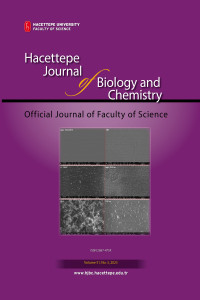Abstract
Cedryl formate is a synthetic fragrance compound, which is an ester derivative of the sesquiterpenoid cedrol, found in different parts of the cedar tree/cedarwood with a characteristic fragrance. Cedryl formate is used in cosmetics and personal care products like fragrances, perfumes, as well as in the chemical and agriculture industries in various forms. In the present work, the microbial transformation of the formate was evaluated by 13 fungal cultures to produce new derivatives. Among the evaluated, the plant pathogenic fungus Aspergillus niger NRRL 326, biotransformed to the metabolite 8-cedren-3β-ol derivative with 6.2% yield. The structure of the chromatographically purified metabolite was elucidated by NMR and spectroscopic methods.
Supporting Institution
Scientific and Technological Research Council of Turkey
Project Number
Grant no: 00530.STZ.2010-1
Thanks
The authors would like to thank to the Turkish Ministry of Science, Industry and Technology (Grant no: 00530.STZ.2010-1) for partial financial support. The authors would like to dedicate this work for the 75th birthday of Prof. Dr. Yoshiaki NOMA a master of biotransformations.
References
- M.A. Longo, M.A. Sanroman, Production of food aroma compounds: microbial and enzymatic methodologies, Food Technol. Biotechnol., 44 (2006) 335-353.
- R. Rowe, Chemistry and technology of flavours and fragrances. Blackwell Publishing, Oxford, 2005.
- J.P. Horst Surburg, Common Fragrance and Flavor Materials: Preparation, Properties and Uses. Individual Fragrance and Flavor Materials. Wiley‐VCH Verlag GmbH & Co. KGaA, 2009.
- P. Kraft, Perspectives in Flavor and Fragrance Research. The Search for New Fragrance Ingredients for Functional Perfumery, 2005.
- J. Scognamiglio, C.S. Letizia, A.M. Api, Fragrance material review on 1-(3,3-dimethylcyclohexyl)ethan-1-one. Food Chem. Toxicol.,62 (2013) 56-60.
- R. G. Berger, Flavours and Fragrances Chemistry, Bioprocessing and Sustainability, Springer, 2007.
- Z. Jiang, C. Kempinski, J. Chappell, Extraction and Analysis of Terpenes/Terpenoids. Curr. Protoc. Plant Biol., 1 (2016) 345-358.
- G. Riezebos, J. H. Greaves, The Determination of Cedrol, and the Total Alcohol Content of Oils of Cedarwood, by Formylation, Analyst, 94 (1969) 148-151.
- M. Garriga, A. P. Thurow, T. Thurow, R. Conner, D. Brandenberger, Commercial value of juniper on the Edwards Plateau, Texas Agricultural Experiment Station Technical Report, San Angelo, Texas, USA, 1997.
- Ö. Özşen Batur, İ. Kiran, F. Demirci, K.H.C. Başer, Fungal biotransformation of cedramber, Biocatal. Biotransformation, 40 (2021) 248-251.
- İ. Kiran, K.H.C. Başer, F. Demirci, Ö. Özşen Batur, Microbial biotransformation 3,3-Dimethylcyclohexyl methyl ketone and Antimicrobial Evaluation, Hacettepe J. Biol. Chem., 50(3) (2022) 263-267.
Abstract
Sedril format sedrol molekülünün sentetik esteri olan bir koku bileşiğidir. Sedrol sedir ağacının uçucu yağı dahil farklı bulunan bir seskiterpen aromatik bileşiktir. Sedirin karakteristik kokusunu vermektedir. Sedril format, parfüm ve kozmetik gibi kişisel bakım ürünleri ile kimya, ve hatta tarım endüstrisi gibi alanlarda kullanılmaktadır. Bu çalışmada format substratı farklı 13 fungal kültür ile türevlendirilmesi incelenmiştir. Sonuçlar arasında, bitki patojeni olan Aspergillus niger NRRL 326, substratı %6.2 verimle 8-cedren-3β-ol metabolitine biyolojik olarak ilk defa dönüştürülmüştür. Kromatografik yöntemlerle saflaştırılan metabolitin yapısı NMR ve spektroskopik metodlar kullanılarak aydınlatılmıştır.
Project Number
Grant no: 00530.STZ.2010-1
References
- M.A. Longo, M.A. Sanroman, Production of food aroma compounds: microbial and enzymatic methodologies, Food Technol. Biotechnol., 44 (2006) 335-353.
- R. Rowe, Chemistry and technology of flavours and fragrances. Blackwell Publishing, Oxford, 2005.
- J.P. Horst Surburg, Common Fragrance and Flavor Materials: Preparation, Properties and Uses. Individual Fragrance and Flavor Materials. Wiley‐VCH Verlag GmbH & Co. KGaA, 2009.
- P. Kraft, Perspectives in Flavor and Fragrance Research. The Search for New Fragrance Ingredients for Functional Perfumery, 2005.
- J. Scognamiglio, C.S. Letizia, A.M. Api, Fragrance material review on 1-(3,3-dimethylcyclohexyl)ethan-1-one. Food Chem. Toxicol.,62 (2013) 56-60.
- R. G. Berger, Flavours and Fragrances Chemistry, Bioprocessing and Sustainability, Springer, 2007.
- Z. Jiang, C. Kempinski, J. Chappell, Extraction and Analysis of Terpenes/Terpenoids. Curr. Protoc. Plant Biol., 1 (2016) 345-358.
- G. Riezebos, J. H. Greaves, The Determination of Cedrol, and the Total Alcohol Content of Oils of Cedarwood, by Formylation, Analyst, 94 (1969) 148-151.
- M. Garriga, A. P. Thurow, T. Thurow, R. Conner, D. Brandenberger, Commercial value of juniper on the Edwards Plateau, Texas Agricultural Experiment Station Technical Report, San Angelo, Texas, USA, 1997.
- Ö. Özşen Batur, İ. Kiran, F. Demirci, K.H.C. Başer, Fungal biotransformation of cedramber, Biocatal. Biotransformation, 40 (2021) 248-251.
- İ. Kiran, K.H.C. Başer, F. Demirci, Ö. Özşen Batur, Microbial biotransformation 3,3-Dimethylcyclohexyl methyl ketone and Antimicrobial Evaluation, Hacettepe J. Biol. Chem., 50(3) (2022) 263-267.
Details
| Primary Language | English |
|---|---|
| Subjects | Engineering |
| Journal Section | Articles |
| Authors | |
| Project Number | Grant no: 00530.STZ.2010-1 |
| Early Pub Date | July 14, 2023 |
| Publication Date | July 16, 2023 |
| Acceptance Date | April 17, 2023 |
| Published in Issue | Year 2023 Volume: 51 Issue: 3 |
Cite
HACETTEPE JOURNAL OF BIOLOGY AND CHEMİSTRY
Copyright © Hacettepe University Faculty of Science


